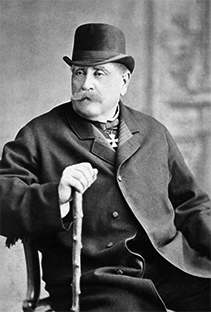Mukhrani (which means "oak-grove") is a historical lowland district in eastern Georgia, in the region of Mtskheta-Mtianeti.
Strategically located on major transit routes traversing ancient and medieval Georgia, forested, easily irrigable and fertile, Mukhrani was an economically advanced area. Today it is something rather less- but with great potential for agritourism, something which a number of foreign organizations and investors are looking into.
The jewel of Mukhrani is the Chateau, a winemaking estate whose brand is exported worldwide. To get there, you must turn of the highway before Gori and drive through the village- a series of low, drab, dusty houses, a few mini-markets, schools and villagers watching the world go by.

But there is more than the Chateau- the village boasts a 16th century two-towered defensive fortification housing a small church, once the location of an educational center used by women as well as men. Inside the church are barely-kept frescos of various ages, and a renovated alter space in all its colorful glory. There is also a pair of Orthodox churches, one of which was given to the vast Armenian community by Prince Ivane Mukhranbatoni in the 19th century.You can visit his original Chateau in the playing field of the local school- a dangerous construction named 'NikoBoer' and now not offering much worth seeing, first abandoned when Mukhranbatoni was captured by the English during the Boer War. It is said there is a wine cellar underneath with buried Qvevri, but the area is so strewn with rubbish, you'll be hard pushed to find it.

For lunch (or dinner) head over to the Chateau (also great for wine tasting and tours).
And here's the history of the village. Keep your eyes on it- the European Bank of Reconstruction and Development has an ongoing program to fund startups and entrepreneurs here and infrastructure permits to beautify the town center are in the pipeline...
[from wikipedia]: In 1512, Mukhrani passed, in hereditary ownership, to a collateral branch of the Bagrationi royal dynasty of Kartli. This occurred when the district was scrounged from King David X of Kartli by his younger brother Bagrat in reward for crucial assistance against the neighboring Georgian ruler George II of Kakheti. Henceforth, the lord of Mukhrani came to be known as the Mukhran-Batoni, and the branch of Bagrations which held it as the Bagrationi-Mukhraneli (some members of which were later naturalised in Russia as the "Princes Bagration-Moukransky"). As royal authority declined, Mukhrani evolved into an autonomous seigneury called a satavado, that is "a holding of tavadi (Georgian principality). It was known as Samukhranbatono, i.e., "[the land] of Mukhran-Batoni." The chief settlement of this princedom was Shios-Ubani, since the 1770s known as the village of Mukhrani, while a fortress built at the confluence of the Mtkvari and Ksani early in the 16th century served as a principal stronghold in the area. Other villages over which the Mukhran-Batoni held sway were Aghaiani, Kandagiani, Tezi, Okami and, for a certain period of time, Lamisqana and Gremiskhevi. The autonomous status of Mukhrani lasted until the Russian annexation of eastern Georgia in 1801, but was not fully abolished until the 1840s.

...And the history of Chateau Mukhrani:
[from the Chateau Mukhrani webpage]: "A great political and military figure of the 19th century Ivane Mukhranbatoni was born the 7thFebruary 1812 into the family of the famous General Konstantine Mukhranbatoni. Young Ivane chose a military career and became Major-General in 1850. In 1853 he was a commander of a Grenadier Division. At the age of 42, having received experience in many battles as a Lieutenant-General, he was appointed Military Governor of West Georgia. As head of the Tbilisi Kingdom Ivane Mukhranbatoni fought for years to eradicate illiteracy in Georgia. Well aware of the importance of education he did all he could to establish schools, was a founder of Tbilisi Georgian State University and licensed newspapers. The Prince’s interest in farming was greatly enhanced on his trip to France in 1875, where he learned more about the fine art of winemaking of the Bordeaux and Champagne regions. On his return home he decided to start producing wonderful Georgian wines on his forefathers’ Mukhrani estate land. Abandoning a brilliant military career he created a superb vineyard and built a 1.200.000 liter capacity Winery, bravely implementing innovation unique throughout the Caucasus."
And as you drive away from the Chateau- in a small park nearby, be sure to grab a photo of two intriguing statues- the first, painted emerald green, is Prince Ivane Mukhranbatoni, the second, a bust painted gold, is Joseph Stalin!!!
By Katie Ruth Davies
